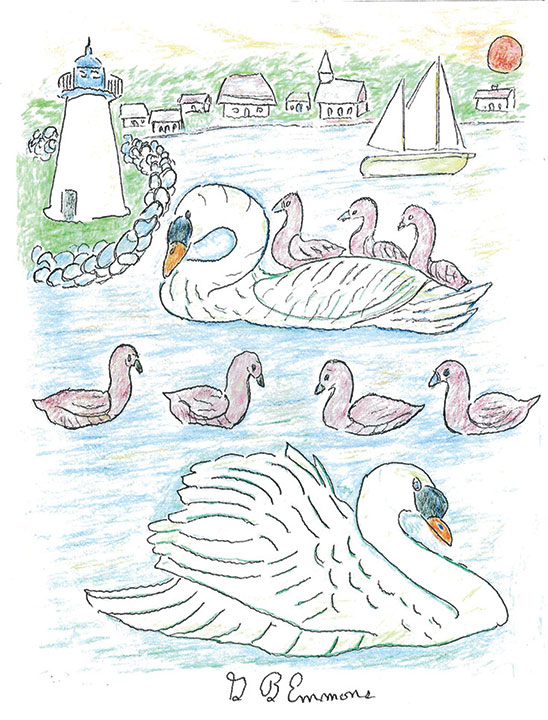The elegant looking Mute Swan is the very same bird of dramatic Russian Ballets and European fairy tales of children’s literature.
They were first brought to this country to decorate and give styling to public parks, ponds, lakes and city zoos. Today their distribution has gone wild by escaping from original purpose. But because of their pristine appearance of white shades and while muzzling each other with curved necks forming a heart shape, they have looked like avian symbols of romantic love by the admiring public.
As in my illustration, the Mute Swan gathering with goslings carried on their backs around Ned’s Point Park, both males and females are aggressive toward people, young children and other waterfowl around the nesting area. They can also be destructive to aquatic submerged vegetation with their long necks by pulling up eight pounds of plants per day and wiping out feeding beds for other bottom feeders.
At the turn of the 20th century, New England state governments suggested restrictions on allowing Mute Swans feeding too deeply.
However, public opinion seriously took the side of the Swans and still wants them protected to this very day for environmental support. One of the reasons for public support is that they have the tradition of mating for life, even though random changing of mates is very common. If a male Swan mates with a younger female, they both join his habitat. But if he mates with an older female, they both will be true and change to her lifestyle. Thus, Mother Nature rules are clearly specified after remating for the future.
Another admiral quality of Swans is the premise that they are believed to sing their own death song on their final flight before they die. This includes the outspoken Trumpeter Swan as well as the northern Tundra Swan, and bird lovers also include the Mute Swan, whose wing beats can be heard as far as a mile away. A pair of Mute Swans are recently often seen patrolling the coastline at the water’s edge on Little Bay in Fairhaven.
I can observe them closely, dipping head and neck toward the bottom with tail up and feeding on seeds, stems and roots of eel grass, moving along thoroughly but destructively as described in my article and illustration impression.
In a few weeks, I will be glad from a literary perspective when they nest and reproduce four or five goslings and help them fledge into the end of summer, remaining with their elegant parents through the first winter as exotic as their ancestor’s original attraction to be imported to this country.
By George B. Emmons
